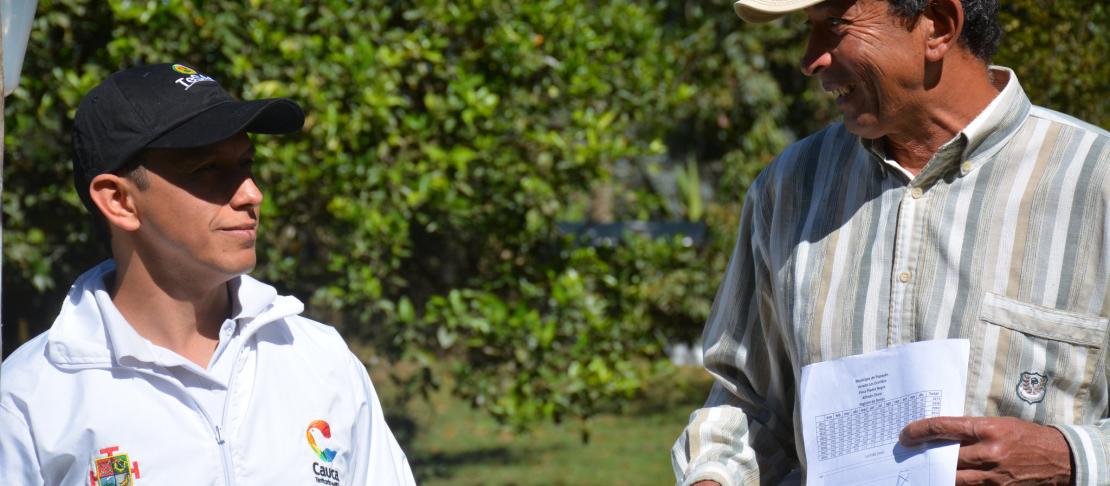Bridging the gap between climate science and farmers in Colombia

A new article in Climate Risk Management explains how Local Technical Agroclimatic Committees can help farmers to understand, use and benefit from agroclimatic information.
Recently, the article "Bridging the gap between climate science and farmers in Colombia" was published in the journal Climate Risk Management. The article describes the approach of the Local Technical Agroclimatic Committees (LTACs) developed by the CGIAR Research Program on Climate Change, Agriculture and Food Security (CCAFS). We talked to Ana María Loboguerrero and Deissy Martínez Barón, two of the co-authors, to get more details:
What is this article about?
This article presents the approach that we have developed in CCAFS for Local Technical Agroclimatic Committees (LTACs), and aims to explain its importance in contributing to the agroclimatic risk reduction of local communities in a climate change and variability context.
What is the scope and what do you want to achieve with this article?
The article is a contribution to the approach of agroclimatic risk management at local scale, which can serve as a reference for further research and also can be used to strengthen the implementation processes of LTACs that being implemented in several Latin American countries.
Additionally, as agriculture sector stakeholders agree on the challenges to increasing resilience and reducing climate variability's negative effects, this article is a proposal to generate, together with farmers and local communities, agroclimatic information. The purpose would be to strengthen their decision-making capabilities when it comes to what to plant, when to plant, when to irrigate, etc. And in general, it would help farmers to understand how best to manage their crops considering an agroclimatic forecast.
Who are the key stakeholders?
One of the main characteristics of a LTAC is the diversity of stakeholders that come together: scientists, technicians, farmers, the public and private sectors. In general, decision-makers at the local level are the key stakeholders. The role of researchers and scientists is to generate climatic and agroclimatic information, which is discussed jointly with the LTAC members. Drawing on their expertise, the members then generate recommendations to minimize the negative effects and take advantage of the opportunities that climate might have on key agricultural systems.
It is important to highlight that public sector stakeholders are also essential, because it is through them that the sustainability of these processes in the countries can be guaranteed and, in addition, they can facilitate scaling-up processes. In the case of Colombia, which is the case described in detail in the article, the Ministry of Agriculture and Rural Development (MADR) was always involved and promoted the implementation of the LTACs. The MADR also worked so that the National Determined Contributions (NDC) include the establishment of at least 15 LTACs by 2030. As a result of this, the MADR has been key in making sure that this effort went beyond the two initial LTACs in Cauca and Córdoba, and today eight LTACs have been established in the country. Since 2017, FAO is the organization that supports the MADR in the implementation and scaling of the LTACs approach, initially developed by CCAFS.

Talking about the importance of climatic tools. Photo: Laura Lopez (CCAFS)
What is the most important message that you want to emphasize from the article?
The first message is that farmers and rural communities can make better decisions if they have access to local agroclimatic information that responds to their challenges and tells them about their conditions so that they generate grounded and actionable recommendations. Farmers respond better to climate challenges when they participate in formulating the responses rather than taking responses formulated by outsiders. The second is that, it is essential to promote dialogue among scientists, technicians, the private sector, decision makers and farmers to implement effective actions to reduce agroclimatic risk. Third, the involvement of national government institutions is key to guaranteeing sustainability and scaling of this type of approach. And finally, strengthening the capacities of the stakeholders involved at the national level and members of the LTACs is key. For example, the Meteorological Services, the Climate Change Units of the Ministries of Agriculture, and producers’ associations, as well as technicians and farmers.
What are the next steps?
This article explains the inception of the LTAC approach and how it was developed in Colombia. But LTACs have been initiated or developed in other countries such as Honduras, Guatemala and Nicaragua through South-South exchanges that started in 2014 with Senegal. So it could be interesting to analyze from a more scientific perspective the different processes that have been taking place, and possibly writing another article that compares these processes. Likewise, we will continue working to generate more evidence on the impact of the LTAC approach in reducing agroclimatic risks for a better adaptation to climate change and variability.
Additionally, CCAFS and the International Center for Tropical Agriculture (CIAT) will continue to provide technical inputs to the countries that are implementing the approach and those interested in initiating its implementation. A Manual for the Establishment of LTACs will be published soon, providing step-by-step guidelines for implementing the approach. The manual was specifically produced for leading institutions in the agricultural sector interested in implementing a discussion space in their region.
In the manual, the approach is divided into seven clear and logical steps that are carried out with participating institutions. Each step is based on what was covered in the previous steps. Thus, the first steps focus on the establishment of the LTAC, climate information and different crops, with a cross-cutting component of capacity building. The following steps involve participating in a dialogue on possible climate impacts on specific crops and identifying best-bet adaptation practices. These will be translated in the local agroclimatic bulletin, and finally, the person in charge will have the responsibility of spreading the newsletter through their networks (to farmers, extension services, etx.), and bringing findings and feedback to the LTAC.
Laura Lopez was formerly the Communications Officer for CCAFS Latin America.



